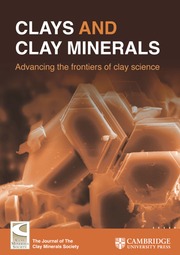No CrossRef data available.
Article contents
Exploring the impact of degrees of hydration on the stress–strain response of Ca-montmorillonite
Published online by Cambridge University Press: 18 July 2025
Abstract
The evolution of the crystal structure and mechanical behavior of Ca-montmorillonite (Ca-Mnt) under varying degrees of hydration is crucial for understanding its swelling properties. The objective of the present study was to investigate systematically the microstructural changes and stress–strain response of Ca-Mnt through molecular dynamics (MD) simulations, supplemented by experimental validation. By employing stress–strain hysteresis curves, the equivalent damping ratio was characterized by quantifying the impact of hydration on energy dissipation. The results indicated that, within the investigated hydration range, the absolute value of the mean H2O–Mnt interfacial interaction energy decreased with increasing hydration; as the water content increased from 300 mgwater per gclay to 420 mgwater per gclay, the average interfacial energy was reduced by ~2.65 eV Å–2. Hydration had a significant influence on the mechanical properties of Ca-Mnt, particularly in the Z-direction, in which the tensile strength decreased, whereas the compressive strength increased with greater degrees of hydration. The stress–strain hysteresis curves shifted progressively to the right as hydration intensified, demonstrating pronounced non-linearity and energy dissipation characteristics. The equivalent damping ratio initially decreased and then increased with increasing degrees of hydration, highlighting the dual effect of hydration on energy dissipation. This study validates the reliability of the simulation results and provides theoretical insights for understanding the hydration-induced expansion mechanisms of montmorillonite and its engineering applications.
Keywords
Information
- Type
- Original Paper
- Information
- Copyright
- © The Author(s), 2025. Published by Cambridge University Press on behalf of The Clay Minerals Society


